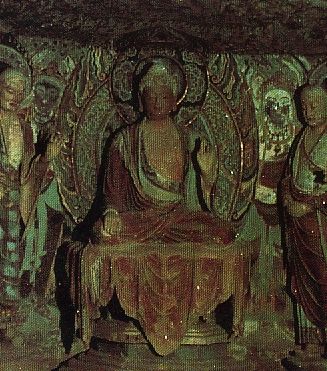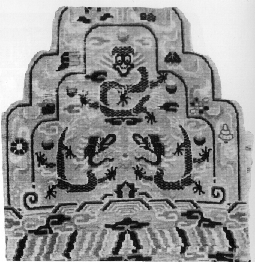Posted by Vincent Keers on 01-12-2002 09:44 PM:
Flames
Dear Daniel,

This Chelaberd design is generally called a half medallion.
In my opinion it has some relation with Buddhist art.
Buddha is mostly portrayed with flames in a circle around him.
In Chinese rugs the design can be seen at both ends of rugs.
The Chelaberd treats the design in the same manner.
What was first? The Chelaberd? The China rugs?
We know Buddhist art was already around for a while.
Best regards,
Vincent
Posted by Patrick Weiler on 01-13-2002 11:37 AM:
Flaming Flower
Vincent,
Would this not be representative of the ubiquitous Lotus Blossom? The flowers would appear flame-like in shape,
almost as if the Buddha were sitting in a pan of flames. The version you show above is "upside down",
but that is not unlikely considering the artistic distance from the source.
Heatedly yours,
Patrick Weiler
Posted by Deschuyteneer daniel on 01-16-2002 11:29 AM:
Dear Vincent,
I disagree with you, because a clear lineage between the early classical, floral Caucasian rugs and the later Kazak
Kasim Ushag and Karabagh Chelaberd rugs, can be traced.
Thanks,
Daniel
Posted by Vincent Keers on 01-17-2002 11:55 AM:
Dear Daniel,
I agree with you.
So, what are we talking about?
Grab a book and you'll see everything is already said before. We will not reinvent the wheel.
I'll post some images now, and maybe it will ring a bell. Shakyamuni's body, Buddha, didn't burn in the fire, but
went up into Nirvana unburnt. So flames in early Buddhist art.
The design in Mongolian and Chinees rugs are said to be "The holy Mountain".
Again looking at the design, they do seem to have something that combines them in a certain way.


Thanks for giving it some thought.
Best regards,
Vincent
Posted by Patrick Weiler on 01-17-2002 11:11 PM:
Vincent,
Your pictures are nice, but this one:
http://www.dzogchen.org/library/photos/pix960502/untitled35.jpg
shows what appear to be flames, but are actually the lotus blossom, beneath the Buddha.
This becomes stylized in later statues, but in this version it retains the bowl-shaped blossom which could have
been transferred to Caucasian rug designs. Remember, northern India is just across the border from eastern Turkestan,
a few short stops along the trade routes.
Notice also the pearls in the Buddha's hand. Does the Cintamani design come to mind?
Cinta-latingly yours,
Patrick Weiler
Posted by Vincent Keers on 01-18-2002 07:04 AM:
Hi Patrick,
I agree with you. The blossom has something to do with it. The floral designs in Chinees rugs seems to be 19'th
century invention. The rugs became more and more floral because of western demand.
So I'm looking at older pre-15'th century religious art. I've learned it was the fashion of the day to look Mongolian
in the 13'th, 14'th, century.
Chinees/Mongolian culture had a strong influence and the Mongolian empire became Islamic.
I'm not saying the Chelaberd design is completely, directly connected, but the holy mountain and the flamelike
designs in old Buddhist art and the dragons seem all to be in the Chelaberd. So maybe some designer in the 20'th
century had a good look at different, but somehow connected Religious art.
Can't help it, but I can't see a floral related design in the Chelaberd. Some small designs are flowers, no imagination
needed there.
So, if Daniel is looking for outside influence, pre 17'th century in the Caucasus, this could be a lead. If not,
what's the use of this Salon? Pick up a book and quote everything that's already accepted.
One third of the world thinks Islamic.
One third of the world thinks Christian.
Most litrature w're reading is Western/Christian.
If that's all there is........
And if I'm wrong, it will not harm anyone to study Buddhist art. Maybe it can enlighten some of us?
Best regards,
Vincent


